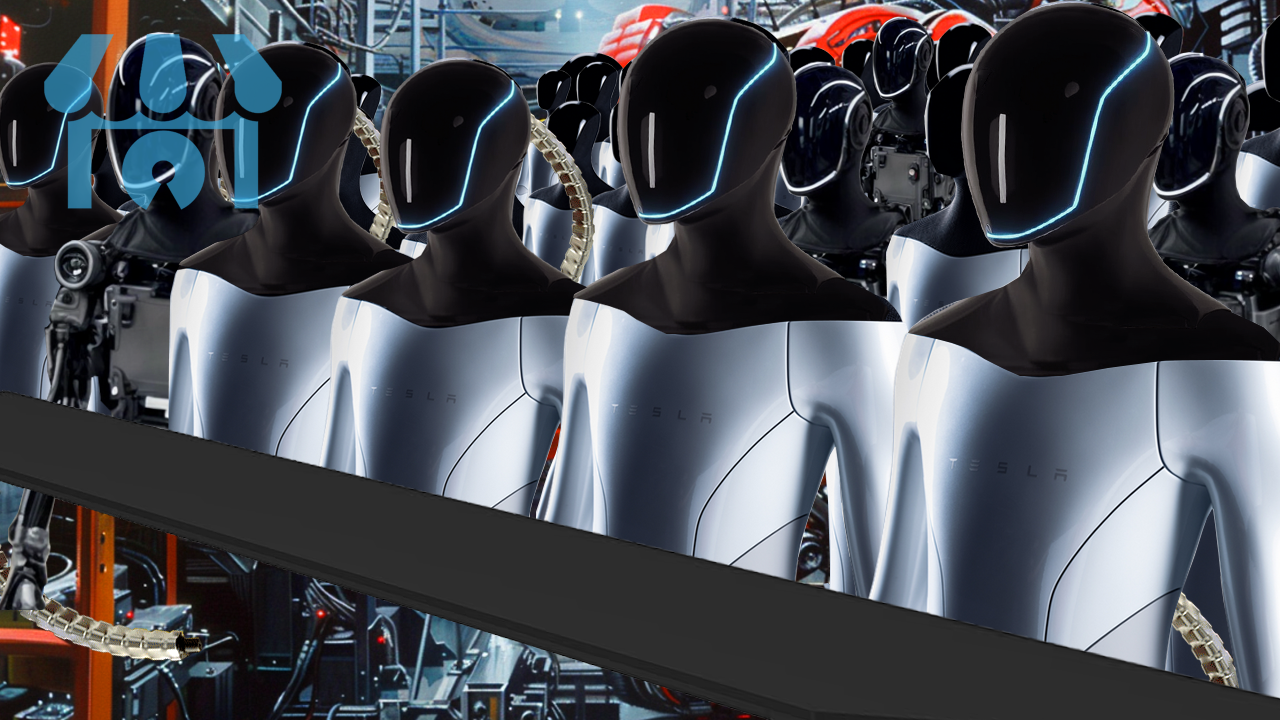How Tesla Will CONTROL the Robot Economy

Tesla’s humanoid robot may be coming in faster and stronger than people think. Elon Musk has plans to deploy 10,000 units this year and to 10x that annually going forward, with customer deliveries beginning in 2026. He predicts that the Optimus bot will not only be Tesla's largest product, but may be the largest product ever, redefining work, transforming industries, and reshaping the global economy.
Musk estimates that Optimus will require 10x more training compute power than what Full Self-Driving needs in the realm of vehicles. But this will enable Tesla’s robot to be 1000x more capable in terms of the various types of tasks and complexity that it can handle. However, even more powerful than a single Tesla Bot is a fleet of Optimus workers. But Tesla may have a secret weapon, a hidden network, that could amplify Optimus's potential far beyond anything we've imagined.
Optimus will be huge, but Tesla hasn’t been clear on exactly how it plans to make money with the robot. The company has mentioned a price tag of $20,000 to $25,000 dollars, or at least something that’s much less than a Tesla vehicle. But as we discussed in our last video, selling enough robots to hit the $10 trillion dollar revenue target that Elon Musk predicts would require hundreds of millions of robots to be sold each year.
Leasing Optimus out to businesses makes much more sense and appears to be in line with Tesla’s revenue targets. Companies could pay effectively a salary for Optimus based on the complexity of the work and the up-time. Tesla would have to have an app store of sorts, listing the various tasks that Optimus is capable of along with the yearly wage or subscription fee. This would save money for employers over traditional labor costs, as there would be no additional fees such as health or retirement benefits required, and Tesla would be paying for maintenance and the cost of the robot itself. However, this is still something that perhaps only companies could afford, as it’s synonymous with hiring an employee, but it may put Optimus out of reach for regular individuals. This could be a huge market, but how would they get access to the power of Optimus without paying a yearly wage to a robot?
The answer might be staring us right in the face: Tesla's existing business model for Full Self-Driving. This is an interesting strategy, where for FSD, Tesla sells the hardware, which is the vehicle, and then they also sell the software or offer a subscription to it, and then they intend to further capitalize on people adding their cars to the Tesla Network, which is where the real money is to be made. Tesla turns into a massive ride-sharing business that undercuts other players due to the low operating costs of EVs, especially with no driver, and they take a cut of every ride, monetizing their existing massive fleet of over 7 million Tesla vehicles, and all vehicles produced going forward.
Optimus is a little different. Or is it? Why not do the exact same thing to create a fleet or hivemind of robots which can swarm together and handle large tasks? An individual may require multiple Optimus robots to help—rake the lawn, or build a shed, or repair a car—whatever it may be. And keep in mind that Optimus will be able to do these intricate tasks—that’s the whole point of Tesla’s relentless focus on getting the robot hands right. Elon Musk says it will be able to play the piano and even thread a needle—which opens the door up for Optimus to do almost anything that a human can do over time.
But purchasing 5 or 20 Optimus robots to accomplish these tasks for individuals makes little sense. Furthermore, companies may have purchased hundreds of robots, some of which may be sitting idly if there's no immediate task available for them to work on.
And so Tesla could introduce the concept of an Optimus Network, which would be a way of entering robots into the sharing economy, leveraging Tesla’s existing infrastructure and expertise, in the exact same way that they do for Full Self-Driving, where people will be able to add or remove their personal vehicles into the Tesla Network. The costs of building and maintaining an Optimus robot are also now offloaded to the consumer that made the purchase, which is exactly how vehicles work today.
The incentive here for Optimus is that customers who purchased the robot will want to make money off of Optimus while it’s not in use. And on the other side of the equation, new consumers who have no access to Optimus will now be able to not only access Optimus on demand, but they would also be able to lease small fleets of Optimus robots on demand for certain periods of time. Tesla could charge by the hour and give the bulk of the revenue to the owner while taking a fee for providing this network and this service. This essentially turns Optimus into Amazon Web Services where people can rent out time slices of robotic help, abilities, and expertise, on demand, and just pay for the time that they use it for.
This way, for instance, users can summon, say, 5 Optimus robots at a time to rake their lawns, or clean the house, or whatever the task may be, and they would only be paying for a few hours of work, rather than having to purchase multiple robots.
But there's something still missing here. How would the Optimus robots physically get to where they need to go? They're not going to walk there. It turns out that Tesla will also be managing a massive fleet of autonomous robotaxis. They can leverage this fleet in order to automatically transport Optimus robots as well. The service’s buyer would pay a small amount of money to the Tesla robotaxi network for the transport of these robots, which will be a small fraction of the hourly rate based on the value Optimus is adding. But because Tesla owns both systems, both networks, they can be seamlessly integrated together into a single experience where the additional cost and logistics of finding and shipping over an Optimus robot will be taken care of by Tesla for a single price that the user pays on the Tesla app. This way, Tesla’s massive fleet of vehicles can be automatically leveraged to transport their fleet of Optimus robots anywhere they want. And multiple robots can now join up to form small fleets and swarm together in order to accomplish larger and more complex tasks. No one can do this except for Tesla.
It's interesting that in the same way that most of the Internet's data, which was originally generated primarily by humans, is now generated and processed mainly by machines, so too could that happen with transportation. If Tesla's Optimus ultimately grows to hundreds of millions or billions of robots, many robotaxi rides will simply be used to transport robots!




